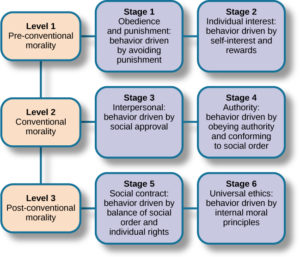Responsibility
Teaching responsibility as well as accountability may be one of the harder things that you take on as a teacher. There is no standard; there is no guide. There is only what you think is the best way to foster responsibility inside your classroom. To me, the best idea in teaching responsibility and teaching students to regulate their own learning and behaviors is to talk about and teach Kohlberg’s scale of moral development. This idea came from Rafe Esquith’s book Teach Like Your Hair’s on Fire. You can see how I applied the levels to cooking dinner here.
 Level 1 of Kohlberg’s scale is preconventional morality. In stages 1 and 2, students are very self-centered. Rules are obeyed to avoid punishment or for personal gain. Level 2 moves into conventional morality where students obey for their teachers approval or because they want to maintain order in the classroom. Level 3 is called postconventional morality and becomes centered around others. Stage 5 thinkers obey rules if they make sense and don’t infringe on their rights or the rights of others. If a teacher wants to encourage this, he or she may decide to allow the class to create the classroom rules together in a very democratic way. The final stage of Kohlberg’s scale is the morality of conscience. At this level, students create their own rules to live by in accordance with personal ethical principles.
Level 1 of Kohlberg’s scale is preconventional morality. In stages 1 and 2, students are very self-centered. Rules are obeyed to avoid punishment or for personal gain. Level 2 moves into conventional morality where students obey for their teachers approval or because they want to maintain order in the classroom. Level 3 is called postconventional morality and becomes centered around others. Stage 5 thinkers obey rules if they make sense and don’t infringe on their rights or the rights of others. If a teacher wants to encourage this, he or she may decide to allow the class to create the classroom rules together in a very democratic way. The final stage of Kohlberg’s scale is the morality of conscience. At this level, students create their own rules to live by in accordance with personal ethical principles.
You may be asking yourself, “how do I help students determine what’s ethical?” That’s easy. You yourself should be ethical and act in moral and ethical ways. Modeling is the best way to teach kindness, care, respect, accountability, and responsibility. I model what I expect to see in my students and teach level 6 thinking.